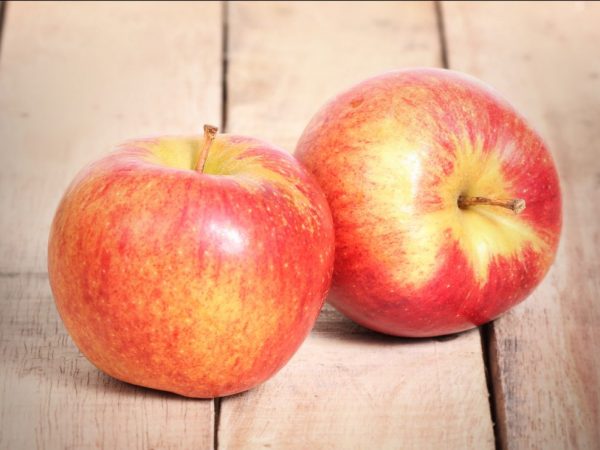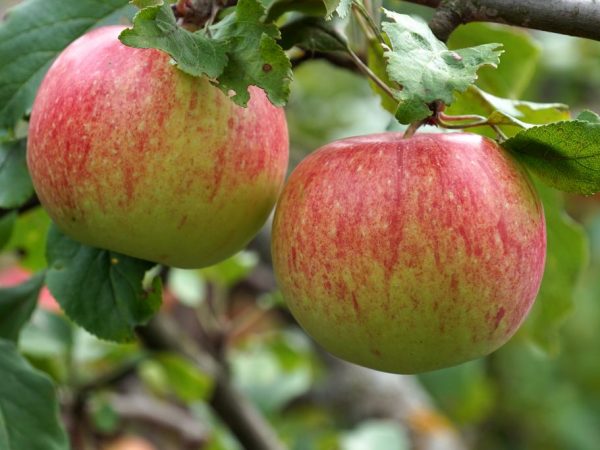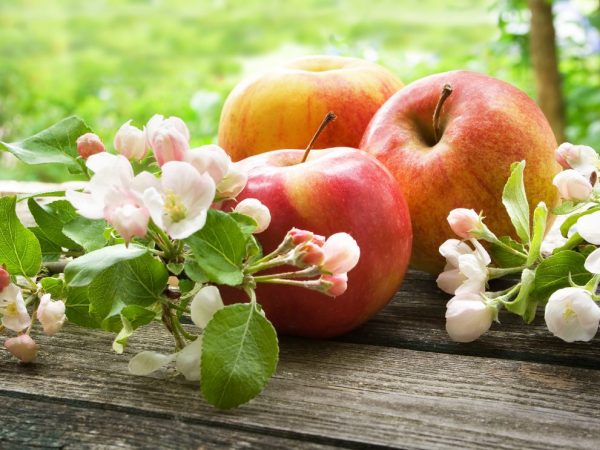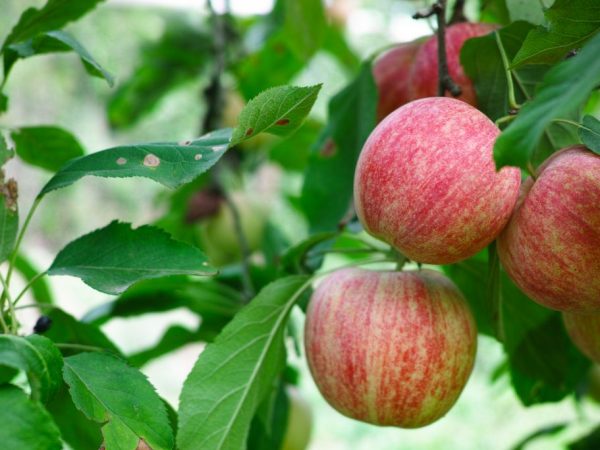Apple variety Veteran
In the past few years, the Veteran apple tree has become increasingly popular among gardeners. The success can be attributed to good yield and early maturity, high resistance to low and high temperatures and diseases. Consider the features of planting a plant and caring for it.
- History of creation
- general characteristics
- Advantages and disadvantages
- External description
- Taste
- Yield
- Pollinators
- Drought resistance and winter hardiness
- Disease and pest resistance
- Transportability
- How is it used
- Landing
- Timing
- Technology
- Care
- Watering
- Top dressing
- Pruning and shaping the crown
- Preparing for winter
- Loosening and mulching
- Features of ripening and fruiting
- Gardeners reviews

Apple variety Veteran
History of creation
The plant was bred by Soviet scientists from the Oryol Fruit and Berry Station of the All-Russian Research Institute for Breeding Fruit Crops - E. Sedova, M. Mikheev and N. Krasov in 1961.
The "parent" is the American variety King, from the fruits of which seeds were sown, freely pollinated by other trees and adopted their genes.
As a result of all these actions, a new winter apple variety Veteran appeared. The first fruits grew after 8 years.
After 20 years, in 1989, having passed all the necessary state tests, permission was given to grow crops in the Central Black Earth regions of Russia and in 6 regions of the Byelorussian SSR.
general characteristics
Winter variety, high-yielding and fast-growing. Great for active gardening. The fruiting period begins at 4-5 years. Fruiting is of a mixed type.
The time of flowering comes in mid-May, harvesting is done in the second half of September.
Life Expectancy:
- average - about 40 years old;
- with proper care - up to 60 years.
Advantages and disadvantages
Based on the description of the Veteran variety, the long life of the apple tree, high yield rates and fast ripening of fruits can be attributed to the advantages of the culture.
Other positive characteristics:
- good keeping quality: when stored in a cold room, the apple retains its taste and appearance until the second half of March.
- unpretentiousness: the plant does not require complex care.
- the tree can withstand sub-zero temperatures, although not too cold.
The disadvantages include:
- with high humidity and rainy climates, the plant is often infected with scab;
- with a lack of moisture, during dry periods, the foliage falls off prematurely;
- for Central Russia, with its cold winters, the tree has a not too high level of frost resistance.
This is interesting: In Germany, in some rural areas, for a long time there has been a tradition to plant an apple tree at the birth of a baby. The fate of the newborn is determined depending on its growth and development.
External description
Medium length tree. does not exceed 3 m. Crohn's spherical, regular shape. Consists of growing thin twigs without thickening, covered with dark brown bark, with tightly pressed buds.
The leaves grow on small petioles, have an elongated elliptical shape. The edges curl slightly upward. The leaf plate is faded, wrinkled.
The flowers are light pink, oblong, small.The stigma is much lower than the anthers.
Description of fruits:
- small, average weight 100-140 g;
- the shape is round, slightly flattened, with a conical top;
- the peel is dense, glossy, with the effect of a waxy coating, dotted with orange strokes, subcutaneous points are clear, infrequent;
- color - in ripe fruits, golden greenish-yellow tint, ruddy barrel, creamy pulp;
- aroma is poorly expressed.
Taste

Juicy and tender apples
Apple Veteran has a tender and juicy pulp, light in structure. Due to the sugar and acids (ascorbic, titratable), pectin, vitamin P included in its composition, it has a pleasant sweet and sour taste and delicate aroma.
A professional tasting evaluation of the fruit was carried out. According to the 5-point system, it ranged from 4.3 to 4.5 points, which is a good result.
Yield
From one tree, depending on its age, you can get:
- 8-9 years old - from 40 to 60 kg;
- 13-15 - up to 80 kg.
From 1 hectare. on average, up to 200 quintals of apples are harvested. The optimal collection period is after September 15th.
Pollinators
The tree has a convenient property: it is self-fertile. Pollination occurs at the expense of its own pollen. It means that:
- he does not need a suitable temperature regime;
- the yield does not depend on the summer of the bees.
If cross-pollination does occur, then trees with an autumn or winter ripening period will be the most successful.
Drought resistance and winter hardiness
As mentioned above, the plant has an average degree of winter hardiness. It is able to withstand subzero temperatures, provided that they are not too low.
Both waterlogging and lack of moisture are negatively reflected on the tree: in the first case, the protective ability to resist diseases decreases, the second leads to premature leaf fall.
A bit of history: in Ancient Russia, an apple orchard was first planted in the 11th century, during the reign of Yaroslav the Wise. There was a landing on the lands of the Kiev-Pechersk Lavra.
Disease and pest resistance
According to the observations of many summer residents, the Veteran apple tree has an average degree of disease resistance. This is especially true for such serious diseases as scab and powdery mildew, which can cause significant damage to the size of the resulting crop.
Under normal climatic conditions, it resists such ailments. In a rainy, damp climate, its protective functions are reduced, and the risk of fungal growth increases.
Like other fruit trees, the plant is attacked by various pests. Among them:
- flower beetle weevil feeding on swollen buds;
- a hawthorn butterfly, from the eggs of which caterpillars appear, eating buds, eating buds, leaves;
- codling moth - its larvae, located inside the apple, lead to its spoilage, early fall;
- honeydew, sucking juice from leaves;
- green aphids, feeding on juice from buds and leaves, especially preferring young plants, young seedlings;
- bark beetle (fruit sapwood) - eats wood and bast, thereby disrupting the tree's nutritional system.
Most often, pests affect weakened crops. Their activity is able to reduce disease resistance, reduce the level of winter hardiness.
Transportability
The fruits have a dense skin and a fairly tight flesh. Thanks to this, the Veteran has good transportability, easily carries the road. Proper packaging of fruits and proper storage are of great importance.
How is it used
Fruits are commonly eaten in a wide variety of forms:
- in a natural, natural form;
- drying and receiving dried fruits;
- squeezing out juice;
- cooking jam, marmalade, jams;
- adding as a filling to confectionery, etc.
All these types have wonderful taste and aroma.
Landing

Saplings take root better in spring or autumn.
In order for the plant to please with a healthy look, good harvest and longevity, it is very important to comply with all planting terms and technologies.
Timing
- In spring - after the threat of frost has passed, before bud break.
- In the autumn period - 2 months before the appearance of the first frost, i.e. at the end of September.
Most summer residents and gardeners believe that autumn apple trees take root better.
Technology
If the apple tree is planted in the spring months, then the planting hole should be dug in the fall. For autumn planting, it is prepared a month before disembarkation. Recommended size: 80X80 cm.
Important! If several seedlings are planted, then the distance between them should not be less than 3.5-4 m, and between rows - 5 m.
The dug hole is filled with a mixture consisting of:
- fertile topsoil;
- organics: rotted manure, ash, compost;
- potash fertilizers;
- mineral phosphorus fertilizers (superphosphate).
It is not recommended to add nitrogen and lime: this can lead to burns of the root system. If clay prevails in the soil, coarse sand and earth are poured in a 1: 1 ratio.
Drainage must be compacted. Pour it in such an amount that it rises in a bunch above ground level.
When planting in a hole, a recess is made according to the size of the rhizome, a support peg is driven into the center of the hole. When backfilling with earth, the trunk is dumbly shaken, to eliminate voids, the soil mixture is tamped. The planted tree is tied to a peg and watered with 2 buckets of water.
Care

Increasing yields with the right care
Proper care of an apple tree can significantly increase the yield. Care should be comprehensive, include compliance with several conditions at once.
Watering
Watering on time can result in more fruit being harvested.
The seedlings are watered during planting and after 10-14 days (with the same amount of water - 2 buckets). Irrigation at this dosage is repeated after another same period of time (under dry weather conditions).
For mature trees, use the following scheme:
- Before the leaves dissolve;
- 2 weeks after flowering;
- A couple of weeks before the fruit ripens;
- The last time was in October.
It is best to carry out the procedure in the evening, using sprinkling. Each time after this, loosening and mulching of the earth around the trunk is required.
Top dressing
When planting, all the necessary fertilizers are applied to the soil, therefore, for the first 3 years, it is enough to feed young plants with organic matter once a year, in spring.
In adult fruit-bearing trees, all useful microelements "take" the harvest, so they need more frequent and rich feeding.
- Early spring. They are fed with nitrogen.
- Before flowering. It is useful to fertilize the tree with complex means.
- After dropping the buds, before pouring the fruit: once every 3 weeks, mineral phosphorus fertilizers are applied under the root.
- Autumn period. To prepare for winter and increase resistance, it is necessary to introduce organic matter, potassium and phosphorus.
Compliance with the feeding scheme will make the plant stronger, enhance its protective properties against external negative factors.
Pruning and shaping the crown
For better yields and well-being, the variety needs pruning and crown shaping.
The first procedure is carried out at landing: the top is cut off on the main trunk.
In adult, fruiting trees, the lower branches are also not touched, the crown is removed by about 2/3, cutting off vertically growing shoots, dried branches and shortening too long side branches.
This allows the sun's rays to better penetrate the ripening fruits.
Preparing for winter
Before the first frosts, the trunk circle is thoroughly loosened, mulched with organic fertilizers or sawdust. The barrel is whitewashed:
- for a young seedling - with a chalk solution;
- in an adult tree - lime.
The barrel prepared in this way is wrapped with parchment paper or non-woven covering material.
Loosening and mulching
Loosening of the root area should be carried out the next day after watering. This will improve air exchange and oxygenation of the soil.The filtration coefficient of water permeability will increase, moisture access to the roots will be facilitated.
The procedure for mulching the trunk circle will help to reduce the loss of moisture from the hole, to protect the topsoil from overheating. It will also reduce the growth of weeds.
Information: a layer of mulch of 5-7 cm reduces the spread of weeds by several times.
Features of ripening and fruiting
The plant is corrugated. Apples ripen in the last decade of September. The fact that the fruit is ripe is indicated by a red-orange spot formed on its side.
The first fruits are removed 4-5 years after planting, and by 8-9 years it already gives a full, impressive harvest: from 60 to 80 kg per tree.
Gardeners reviews
An apple tree with an unusual name Veteran can become a wonderful choice for gardeners in the Central Black Earth zone of Russia.
The variety is distinguished by tasty fruits, unpretentiousness, good resistance to transportation and storage: with proper care, apples can delight the whole winter and even spring.

